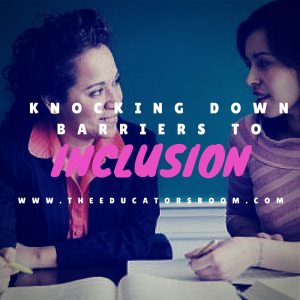 By now you know that inclusion is here to stay. The education of students with special needs is no longer the responsibility of just special education teachers. The inclusion of students with disabilities in the general education setting is now the norm rather than the exception. However, for many teachers (including special education teachers) there are certain barriers that may prevent successful inclusion in your class.
By now you know that inclusion is here to stay. The education of students with special needs is no longer the responsibility of just special education teachers. The inclusion of students with disabilities in the general education setting is now the norm rather than the exception. However, for many teachers (including special education teachers) there are certain barriers that may prevent successful inclusion in your class.
Before I identify at least 3 barriers, let me define what inclusion is. Inclusion is the practice of bringing services and support to children with special needs into the general education classroom, as opposed to removing special needs students from learning experiences with their same age peers (Kilanowski-Press, Foote, & Rinaldo, 2010). Inclusion is basically a legal mandate from the reauthorization of IDEA (Individuals with Disabilities Education Act), which upholds the provision of least restrictive environment (LRE). To make a long story short, if you hate inclusion learn to love it. Chances are that we will leave the classroom before the practice of inclusion will.
Special education teachers are prepared to teach students with special needs (for the most part) as this is what we were train to do. However, the same may not be true for all general education teachers and up until now special education teacher were taught to be an island among themselves. Having general and special teachers work together can be as difficult if not more difficult than the act of including students with disabilities into the general education classroom. The biggest barriers for both are planning, attitude and knowledge.
I think it is an understatement to say that most teachers receive little to no training before students with disabilities are included in their class. Despite this, planning is the key. Both teachers (special and general) most make the effort to plan together. There is no denying that working with students with special needs require a great amount of effort and time. Teaching students with learning disabilities comes with added responsibilities. But, when it comes to organizing your classroom and planning lessons, knowing the type of inclusion model that will be in practice is your first line of defense.
Inclusion programs differ from school to school as does the amount and nature of support given to both general and special education teachers, which is why it can be difficult for teachers to feel prepared to teach in inclusion settings. Let’s face it, student needs are not the only thing driving the direction of inclusion services- funding is also! But here are few things you can do to prepare yourself:
- Seek out the special education “go to person” right away.
- Ask them for a list of the students expected to be in your class or on your caseload.
- Ask them to identify the caseload special education teacher of the students or the general education teachers’ class they will be in and make contact right away.
- Know the individualized accommodations for each student.
- Know the nature and amount of services the special education teacher will provide (e.g. co-teaching or consultation).
- Now communicate with each other (special and general education teachers).
“If you don’t like something change it. If you can’t change it, change your attitude.” What a fitting quote from Maya Angelou because ones’ attitude can be another barrier to the success of inclusive practices. If there are negative attitudes, including territorial issues regarding role overlap and about the practice of inclusion then we most work hard to change them. Working with other teachers is a necessity of any inclusion program. There is no way around it! Working with other teachers and changing the way you teach can be time consuming and scary, but it’s a most if you want to have anything remotely close to a successful inclusion class.
As we work to change our attitude about inclusion, let’s be reminded that:
- Inclusion benefits students with and those without disabilities.
- Inclusion classrooms can help teach tolerance and patience.
- Inclusion classrooms help students to value diversity.
- Inclusion classrooms prepare all students for adult life in an inclusive society.
- Students with disabilities gain greater access to the general education curriculum from the general education expert.
- General education students benefit from the additional resources available in the inclusion setting.
Knowledge is another barrier that can impact the success of an inclusive classroom. While some general education teachers do not feel they have the professional knowledge or training needed to work with special needs students, there are some special education teachers who are not knowledgeable about general education curriculum. This is when the involvement and collaboration between both special and general education teachers is needed the most. A collaborative teaching program requires understanding between general education and special education teachers in regards to instructional
beliefs, time for instructional planning, agreement on the establishment of classroom routines, establishment of classroom discipline norms, and a classroom where both teachers are equally responsible for instruction (as sited in Kilanowski-Press et al., 2010). Kilanowski-Press et al (2010) also suggested that general education and special education teachers must work together in a mutually respectful manner without territoriality or power struggles. Both general education and special education teachers bring a great deal of knowledge to an inclusion classroom. General education teachers share their knowledge of content areas, grade level curriculum, and effective teaching methods, including large group instruction. Special education teachers can facilitate individual learning styles, instructional strategies, clinical teaching, analysis and adjustments of instruction and curriculum, and behavior management. In addition, special education teachers can supplement the work of general education teachers in regard to IEPs that can improve the quality of outcomes for students with disabilities (Hwang et al., 2011).
There is no doubt about it, inclusion can be hard work. But breaking down barriers to inclusion can make it a little easier. Being educated on the importance of inclusion and participating in ongoing collaboration with fellow teachers, the inclusive setting can be filled with meaningful learning experiences for all.
The LD Coach
Work Cited:
Hwang, Y. S. & Evans, D. (2011). Attitudes towards inclusion: Gaps between belief and practice. International Journal of Special Education, 26(1), 136-146.
Kilanowski-Press, L., Foote, C. J., & Rinaldo, V. J. (2010). Inclusion classrooms and teachers: A survey of current practices. International Journal of Special Education, 25, 43-56.





Awesome article!
Inclusion has been around since 1975–I do not know we make such a big deal about it….
Unfortunately Cheir, inclusion may have been around since 1975, but many schools have just within the last 8 years started to really practice this. i know from personal and professional expereince. So, you are one of the fortunate people who have expereienced/seen the better side to education. But for many many many more (including students and teachers), their experience of inclusion (for whatever reason as not been a good one.
I was named Program Assistant for the special education program at a school for a very large urban school distric in 2005. When I stared there was only 1 co-taught math class and kids running me down begging to be placed in regular ed. So let me be the one to inform you, inclusion is a big deal. In fact, there are many well respected educators/researchers that still talk about inclusion a lot. So I think it will stay a big deal for a very long time.
BTW…when I left the position in 2011 althought more kids, well over half, were in gen ed in co-taught classes there were will lots of issues with teacher attitude, students being forced into gen ed to scheduling problems.
We have inclusion in my high school but there is no model to practice. We put 2 teachers together and typically there is no planning time. The special Ed teacher has little input into the class as the core teacher teaches the same in the inclusion class as they do in their other non inclusion sections. I would love to bring an effective model to my school. Does anyone have any suggestions to guide me to research with a proven model for high school?
Inclusion is not a “legal mandate”, in fact, the word inclusion is not mentioned a single time in IDEA. However the only term mentioned concerning this is “least restrictive environment”. Parents of children with special needs fought long and hard to have appropriate places in schools that cover a full continuum of services from the general education classroom to special education classrooms. Let’s always keep that balance that students need exposure to both experiences and keep the “individual” in IEP.